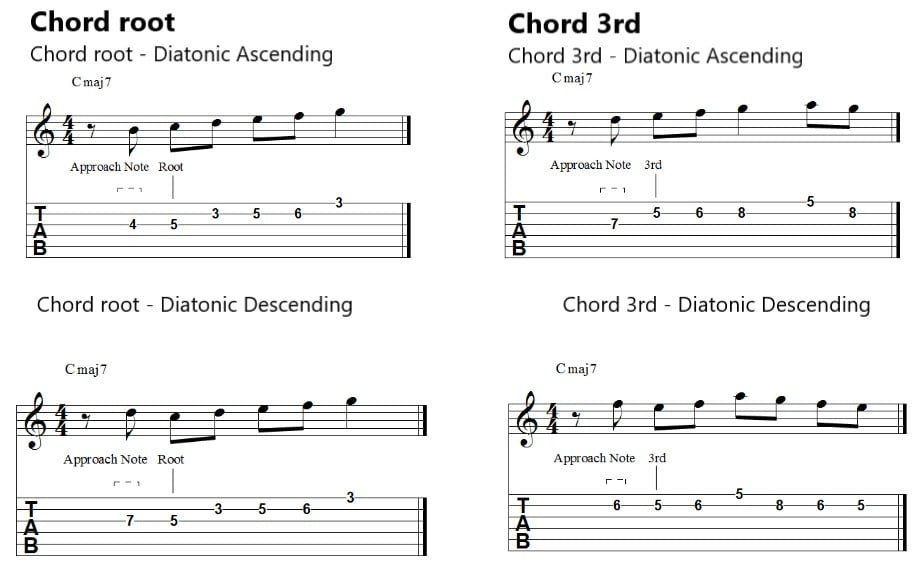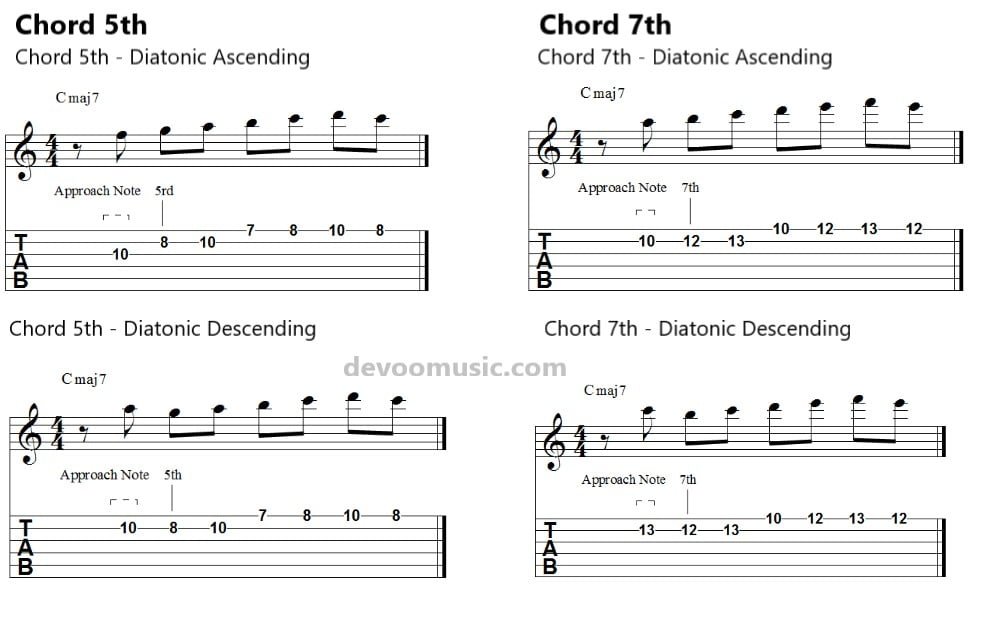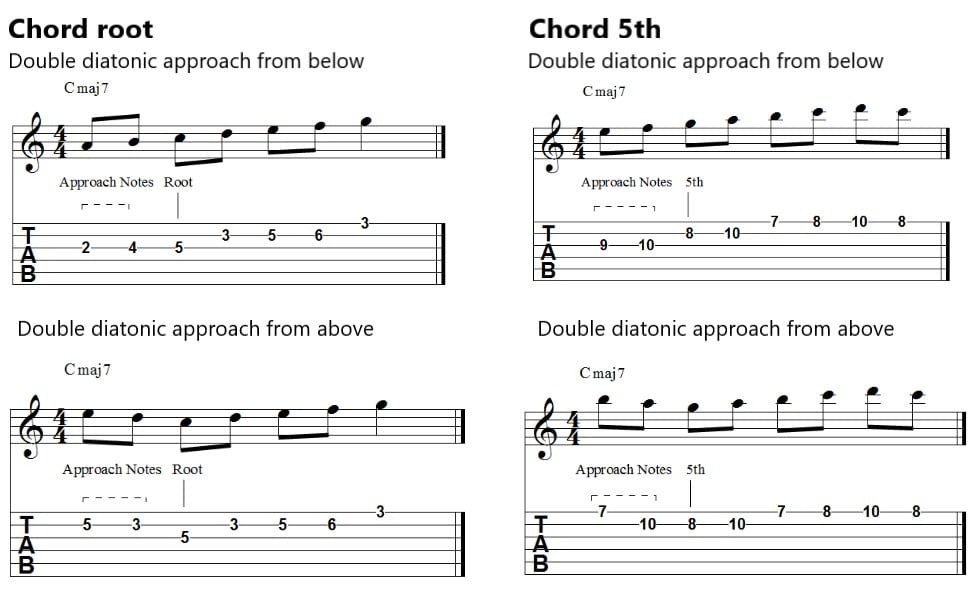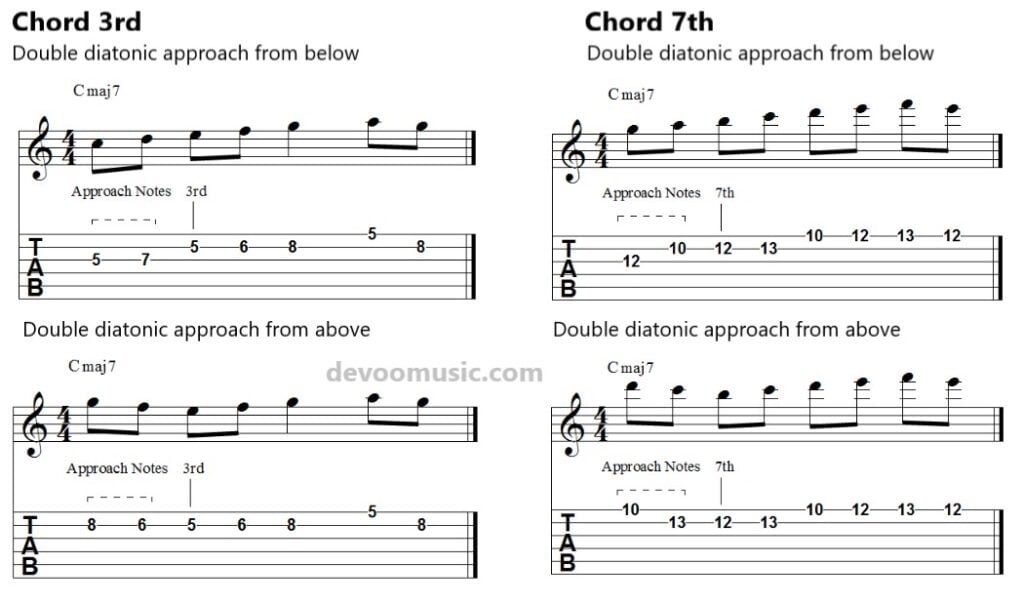
Target Tones
This guitar lesson is about a very important concept used by many jazz improvisers named “Target notes” or “target tones” or “approach notes”. It has to do with targeting chord tones by scale or chromatically.
This technique opens the door to another essential type of targeting called “Enclosures” used to surround a chord tone both diatonically and chromatically from above and below.
Understanding and applying “Targeting” will help you solos sound more jazzy and allow you to expand your harmonic knowledge.
There are many ways to target chord tones. You can use ascending or descending approach notes either diatonic or chromatic. The exercises below show you how to use approach notes in order to target a particular chord tone. Target Tones
It goes without saying that these exercises may be used to any chord type as minor, dominant 7, half-diminished, diminished, etc. Please notice that the “target note” are usually played on the downbeat.
The term “diatonic” means that we will use the notes of the major scale. The principle is to play the notes of the scale that are located just before (below) or after (above) the “target note”.
For example and for more clarity the chord tones are from a C major seventh chord, they represent the most important notes in the chord (root, third, fifth, seventh). So, the target notes will be C (the root), E (the third), G (the fifth) and B (the seventh).
The following diagrams show the relationship between the approach notes (represented by a transparent circle) and the target tones of a major 7 chord. Target Tones

Here are eight patterns that show how to target a major 7 chord tone using the single diatonic approach technique.


The double diatonic approach consist of playing two notes of the diatonic scale in order to target a chord tone.
When using this concept with the aim of targeting from below :
- The chord root, you always play the 6th and the 7th before.
- The chord third, you always play the root and the 2nd before.
- The chord fifth, you always play the minor 3rd and the 4th before.
- The chord seventh, you always play the 5th and the 6th before.
- When using this concept with diatonic notes from above :
- The chord root, you always play the 3rd and the 2nd before.
- The chord third, you always play the 5th and the 4th before.
- The chord fifth, you always play the 7th and the 6th before.
- The chord seventh, you always play the 2nd and the root before.
Here are eight guitar patterns based on a C major seventh chord which, it should be remembered, is built with : root (C), third (E), fifth (G) and seventh (B). Each chord tone is approached diatonically from above and from below. Target Tones


The second way to target notes is to use chromatic approach tones. It means that you will be playing in your jazz improvisations, notes that don’t belong to the tonality. Each chromatic tones will be played on an offbeat a semitone below or above each tones of a chord.
For the following exercises we will be targeting the root (R), the major third (3), the fifth (5) and the minor seventh (b7) of G7. Be sure to do the same work with the main types of triads (minor, major, diminished, augmented) and arpeggios as minor 7 (R-b3-5-b7), major 7 (R-3-5-7), diminished 7th (R-b3-b5-bb7), half-diminished (R-b3-b5-b7). Target Tones



Now that you understand the principle of the single chromatic approach you can make this concept more interesting by playing two chromatic notes from above or from below to target a note of any type of chord.
This technique is a terribly efficient tool when employed over a dominant 7 chord, this will allow you to create short chromatic lines as a bebop player would do.
These six short jazz guitar lines below show you how to approach chromatically each tone of a dominant 7 chord with two notes.
Please, notice that the two examples “chord third double chromatic approach from above” and “chord seventh double chromatic approach from below” imply two dissonant notes on the downbeat, the #11 for the first examples and the b13 for the second. They don’t sound very good at all but can be useful for outside playing. Target Tones


Enclosures are a very important part of the jazz language especially used by bebop players. They are present in many essential jazz lines. This technique consists in approaching a target note with a group of two, three or four notes from above or from below either with a whole step (2 semitones) or a half step (1 semitone).
Enclosures, also known as encapsulations, will help you achieve two main goals, they are a great way to insert chomaticisms in your improvisations and great way to extend your jazz lines. Target Tones
A diatonic enclosure is characterized by surrounding a chord tone above or below using notes within the diatonic scale. You need to know first that a dominant 7 chord is built with Root (R), major third (3), perfect fifth (5) and minor seventh (b7) meaning that G7 contains G (R) – B (3) – D (5) and F (b7).
So, we can use two notes to approach diatonicaly each tone of G7. G, the root, can be enclosed with F# and A. B, (the third) can be enclosed with C and A. D (the fifth) can be enclosed with C and E. Then, F (the minor seventh) can be enclosed with E and G.
The four guitar shapes below help you see clearly the location of the approach notes (transparent circle) in relation with the dominant 7 arpeggios. Target Tones

The eight enclosure patterns in fretboard diagrams, TAB and notation below show you how you can approach diatonically each note a G7 chord from above and from below.


As the title of this chapter implies, a chord tone can be enclosed chromatically from below and above. This is the simplest way to target notes, but it should be played with care because some of these chromatic enclosure patterns can be very dissonant.
Therefore, if you want to bring a little bit of tension to your jazz improvisations, then you are at the right place ! Try these four easy jazz lines below and judge for yourself. Target Tones

Many jazz musicians use a mix of chromatic and diatonic approaches to target a note. The next guitar lines involve targeting chord tones of G7 using scale tones above / chromatic tones below and scale tones below / chromatic tones above. These are the most commonly used enclosures in jazz improvisation, both by guitarists and pianists and any other jazz musicians. Target Tones
This chapter of this free complete guide for guitar student will run through eight easy examples of the diatonic/Chromatic enclosure on the root, third, fifth and seventh of a dominant chord. Don’t forget to apply these concepts about target notes to any type of chord in order to create your own jazz lines. Target Tones


You can use more than two notes to target a chord tone while combining the previous concepts discussed in this lesson. This should add a lot of interest to your jazz guitar solos.
There are a lot of possibilities to enclose a chord tone using three notes. A few examples of how it would apply to the root of a G7 chord are represented below. Be sure to use this concept with all the other chord tones (third, fifth and seventh) of any chord type. Target Tones

The three following patterns illustrate the notes of a G7 chord being enclosed with 4 notes. The possibilities are almost unlimited, so you have to experiment with this technique of targeting with four notes in order to create your own bebop lines.






